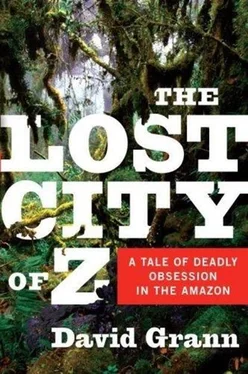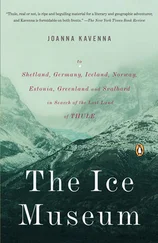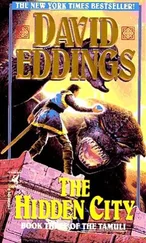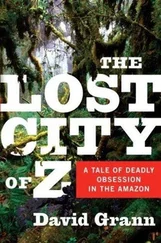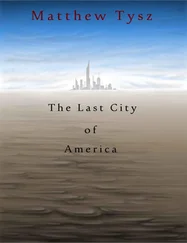Yet in Fawcett's day the Society was helping to engineer one of the most incredible feats of humankind: the mapping of the world. Perhaps no deed, not the building of the Brooklyn Bridge or the Panama Canal, rivals its scope or human toll. The endeavor, from the time the ancient Greeks laid out the main principles of sophisticated cartography, took hundreds of years, cost millions of dollars, and claimed thousands of lives, and, when it was all but over, the achievement was so overwhelming that few could recall what the world looked like before, or how the feat had been accomplished.
In a corridor of the Royal Geographical Society's building, I noticed on the wall a gigantic seventeenth-century map of the globe. On the margins were sea monsters and dragons. For ages, cartographers had no means of knowing what existed on most of the earth. And more often than not these gaps were filled in with fantastical kingdoms and beasts, as if the make-believe, no matter how terrifying, were less frightening than the truly unknown.
During the Middle Ages and the Renaissance, maps depicted fowl in Asia that tore humans apart, a bird in Germany that glowed in the dark, people in India with everything from sixteen toes to dog heads, hye nas in Africa whose shadows rendered dogs mute, and a beast called a “cockatrice” that could kill with a mere puff of its breath. The most dreaded place on the map was the land of Gog and Magog, whose armies, the book of Ezekiel had warned, would one day descend from the north to wipe out the people of Israel, “like a cloud to cover the land.”
At the same time, maps expressed the eternal longing for something more alluring: a terrestrial paradise. Cartographers included as central landmarks the Fountain of Youth, for which Ponce de León scoured Florida in the sixteenth century, and the Garden of Eden, which the seventh-century encyclopedist Isidore of Seville reported was filled “with every kind of wood and fruit-bearing tree, having also the tree of life.”
In the twelfth century, these feverish visions were inflamed when a letter appeared in the court of the emperor of Byzantium, purportedly written by a king named Prester John. It said, “I, Prester John, who reign supreme, exceed in riches, virtue, and power all creatures who dwell under heaven. Seventy-two kings pay tribute to me.” It continued, “Honey flows in our land, and milk everywhere abounds. In one of our territories no poison can do harm and no noisy frog croaks, no scorpions are there, and no serpents creep through the grass. No venomous reptiles can exist there or use their deadly power.” Though the letter was likely written as an allegory, it was taken as proof of paradise on earth, which mapmakers placed in the unexplored territories of the Orient. In 1177, Pope Alexander III dispatched his personal physician to extend “to the dearest son in Christ, the famous and high king of the Indians, the holy priest, his greetings and apostolic benediction.” The doctor never returned. Still, the Church and royal courts continued for centuries to send emissaries to locate this fabulous kingdom. In 1459, the learned Venetian cartographer Fra Mauro created one of the most exhaustive maps of the world. At last, Prester John's mythic kingdom was wiped from Asia. Instead, in Ethiopia, Mauro had written, “qui il Presto Janni fa residential principal”- “here Prester John makes his principal residence.”
Even as late as 1740, it was estimated that fewer than a hundred and twenty places on the planet had been accurately mapped. Because precise portable clocks did not exist, navigators had no means of determining longitude, which is most easily measured as a function of time. Ships plowed into rocks and shoals, their captains convinced that they were hundreds of miles out to sea; thousands of men and millions of dollars' worth of cargo were squandered. In 1714, Parliament announced that “the Discovery of the Longitude is of such Consequence to Great Britain for the safety of the Navy and Merchant-Ships as well as for the improvement of Trade” that it was offering a twenty-thousand-pound prize-the equivalent today of twelve million dollars-for a “Practical and Useful” solution. Some of the greatest scientific minds tried to solve the problem. Most hoped to use the position of the moon and stars to fix time, but in 1773 John Harrison was recognized as the winner with his more feasible solution: a three-pound, diamond-and-ruby-laden chronometer.
Despite its success, Harrison's clock could not overcome the main problem that had bedeviled mapmakers: distance. Europeans had not yet traveled to the farthest ends of the earth-the North and South Poles. Nor had they surveyed much of the interior of Africa, Australia, or South America. Cartographers scrawled across these areas on the map a single haunting word: “Unexplored.”
Finally, in the nineteenth century, as the British Empire was increasingly expanding, several English scientists, admirals, and merchants believed that an institution was needed to create a map of the world based on observation rather than on imagination, an organization that detailed both the contours of the earth and everything that lay within them. And so, in 1830, the Royal Geographical Society of London was born. According to its mission statement, the Society would “collect, digest and print… new interesting facts and discoveries;” build a repository of “the best books on geography” and “a complete collection of maps;” assemble the most sophisticated surveying equipment; and help launch explorers on their travels. All this was part of its mandate to chart every nook and cranny of the earth. “There was not a square foot of the planet's surface to which Fellows of this Society should not at least try to go,” a later president of the institution vowed. “That is our business. That is what we are out for.” While the Society would serve as a handmaiden of the British Empire, what it was out for represented a departure from the previous age of discovery, when conquistadores, like Columbus, were dispatched strictly in pursuit of God, gold, and glory. In contrast, the Royal Geographical Society wanted to explore for the sake of exploration-in the name of the newest god, Science.
Within weeks of its unveiling, the Society had attracted nearly five hundred members. “[It] was composed almost entirely of men of high social standing,” a secretary of the institution later remarked, adding, “It may thus be regarded as having been to some extent a Society Institution to which everybody who was anybody was expected to belong.” The original list of members included acclaimed geologists, hydrographers, natural philosophers, astronomers, and military officers, as well as dukes, earls, and knights. Darwin became a member in 1838, as did one of his sons, Leonard, who in 1908 was elected president of the Society.
As the Society launched more and more expeditions around the world, it drew into its ranks not just adventurers, scholars, and dignitaries but also eccentrics. The Industrial Revolution, in addition to producing appalling conditions for the lower classes, had engendered unprecedented wealth for members of the middle and upper classes in Britain, who could suddenly afford to make leisurely pursuits such as travel a full-time hobby. Hence the rise of the amateur in Victorian society. The Royal Geographical Society became a haven for such people, along with a few poorer members, like Livingstone, whose exploits it helped to finance. Many of its members were odd even by Victorian standards. Richard Burton espoused atheism and defended polygamy so fervently that, while he was off exploring, his wife inserted into one of his manuscripts the following disclaimer: “I protest vehemently against his religious and moral sentiments, which belie a good and chivalrous life.”
Читать дальше
Конец ознакомительного отрывка
Купить книгу
